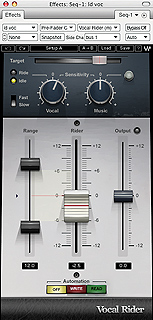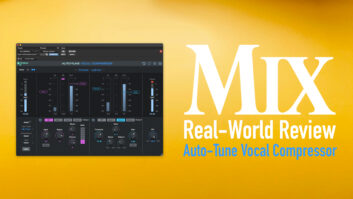
Vocal Rider automatically rides the gain of a vocal track during mixdown. Users can automate the plug-in to modify its action, phrase by phrase.
Tight budgets or deadlines don’t always allow for the manual line-by-line tweaking of fader levels on a vocal track to perfection at mixdown. Waves’ Vocal Rider automatically rides the vocal’s levels for you, saving time and avoiding tedium.
The cross-platform plug-in comes in two flavors: native (RTAS, Audio Suite, AU and VST formats) and TDM. I tested the AU plug in Digital Performer 6.02 using an 8-core Mac Pro running Mac OS 10.5.4.
Well-Read
Vocal Rider’s controls are novel enough that reading the operating manual is a must. A Rider Fader, positioned at the center of the plug-in, automatically makes level adjustments to the vocal track based on the settings of surrounding controls.
The plug-in’s Vocal Sensitivity control helps Vocal Rider differentiate between vocal signal and superfluous noise. For example, if this control is set too low, Vocal Rider may interpret a quiet vocal phrase as noise and won’t ride the level higher to make it more audible.

Vocal Rider’s automation data can be written to the vocal track’s automation lane in your DAW. Here, the last fader move has been edited to provide additional gain boost to a swallowed lyric.
A Target control adjusts the nominal center point of the range over which the vocal’s level will ride. Two Range sliders also govern the Rider Fader’s action by defining its dynamic range. Moving the bottom Range slider lower increases the maximum amount of attenuation that Vocal Rider will apply to overly loud vocal phrases. I found that an indiscriminately low setting of this slider also negatively affects quiet phrases, riding them not as high as they might need to be boosted. On the other hand, the top Range slider increases the maximum amount of boost that Vocal Rider applies to low-level phrases. Set this too high, and any louder vocal phrases can end up being too loud. The bottom Range slider and top Range slider help define the overall dynamic range that you are riding in with relation to the target setting.
Positioned between the two Range sliders, an Idle Arrow can be moved to change the level to which the Rider Fader returns between vocal phrases. Here, a very low setting will decrease noise—such as breath sounds—but can also cause more drastic adjustments when the vocal comes back in, potentially making the track sound jerky. An Attack switch tailors the plug-in’s detector response (fast or slow), which also affects how quickly Rider Fader makes its automatic moves. Once these controls are dialed in and Rider Fader behaves the way you want, an Output fader trims levels while preserving all Rider Fader adjustments.
With some DAWs (including Digital Performer versions 6.02 through 7.01), you can make Vocal Rider consider the fluctuating levels of accompanying instrumental (and background vocal) tracks when determining how it boosts or attenuates the vocal track from moment to moment. You accomplish this by routing the accompanying tracks to a common bus and setting the Vocal Rider’s sidechain input to the same bus via a drop-down menu. Then adjust a Music Sensitivity control to determine how much the plug-in adapts to changing levels in the accompanying tracks. Not all DAWs support this functionality—check Waves’ Website for compatibility with your DAW.
In Write mode, Vocal Rider can write its vocal fader moves to your DAW’s automation lane. Later, you can edit the automation curve to tweak Vocal Rider’s performance dynamically on playback.
My Third Hand
Vocal Rider imposed very negligible drain on my Mac Pro. The slow Attack setting sounded considerably more transparent but let the vocal track peak higher. Phrases that exploded in level at their start tended not to be ridden lower as they ideally should’ve been. Switching to the fast Attack setting, Vocal Rider successfully attenuated loud starts to vocal phrases but also often failed to raise very quiet sections. Generally, I tended to favor the slow Attack setting on singers who tended to swallow syllables, and fast Attack on vocalists who had very explosive peaks. For vocal tracks that presented both problems, I usually slapped a compressor on the track to tame peaks and used Vocal Rider’s slow attack setting to automatically boost low-level tidbits.
Still, without automating the plug-in, Vocal Rider couldn’t smooth out all the fluctuations on a wildly dynamic vocal track. For example, very quiet syllables that followed closely on the heels of loud lyrics usually remained too low after Vocal Rider’s initial adjustments.
Fortunately, automation solved this and all other issues. Setting Digital Performer to automate plug-in parameters and putting Vocal Rider’s automation control section into Write mode, I played the track from start to finish. Digital Performer recorded a data curve—with numerous breakpoints—for all of Vocal Rider’s fader moves to a separate track layer. After editing the breakpoints to boost quietly sung lyrics further, I also edited the automation curve to anticipate vocal levels at the start of some phrases and move the fader before the first utterance. This made the start of these phrases sound better than they did when the plug-in arbitrarily rode them (as fader riding is an inherently lagging action). I also made other edits for creative reasons, such as goosing the song’s hook. Setting Vocal Rider’s automation section to Read mode, the plug-in followed all my edits in Digital Performer perfectly during playback.
Free Ride?
Despite its effectiveness, Vocal Rider isn’t a cure-all for sitting vocals properly in a mix. To make a buried lyric intelligible, sometimes a vocal doesn’t need fader adjustment but instead requires momentary EQ tweaks (for example, to correct excessive bass proximity effect that occurred at the mic during recording). That said, Vocal Rider does exactly what it promises, smoothly riding a vocal track to place it in the general vicinity of perfection. As is the case with all exacting engineering, the final tweaks are up to you.
Mix
contributing editor Michael Cooper is the owner of Michael Cooper Recording in Sisters, Ore. Visit him at www.myspace.com/michaelcooperrecording.

Click on the Product Summary box to view the Waves Vocal Rider product page.







